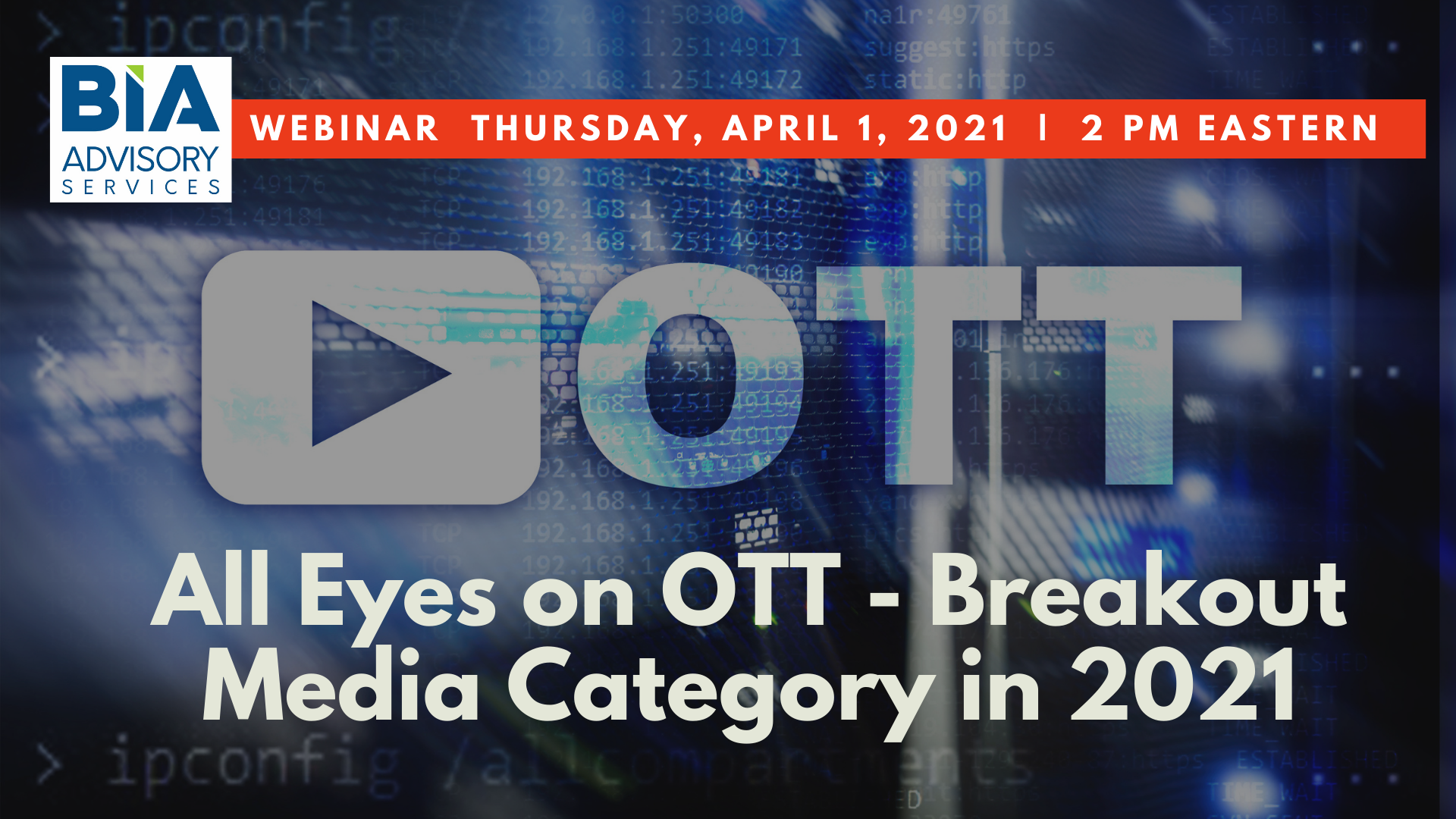Streaming TV became a major force to be reckoned with during the coronavirus pandemic with an explosion of viewing, services, and advertising. Be sure to register for BIA’s upcoming webinar (April 1, 2021) to learn more: All Eyes on OTT – Breakout Media Category in 2021.
OTT is distinguished by its long-form, premium video that can be watched on any Internet connected screen including smartphones, tablets, PCs, desktops, and of course connected TV sets (CTV). As the country renormalizes in the next phase of the pandemic, Over-the-Top TV (OTT) will keep and grow its new important role in the local media ecosystem.
AVOD, SVOD, FAST, vMVPD, DTC
Viewing, ad spending, original productions and innovative business models featuring variations of subscription video on demand (SVOD), advertising video on demand (AVOD) and free ad-supported streaming TV (FAST) services are flooding the market.
Major media brands have launched direct to consumer (DTC) OTT services that consumers can reach individually as well as via platforms and aggregated bundles such as those skinny bundles offered by virtual MVPDs (vMVPDs) as alternatives to cable. More on these services in a moment.
OTT Includes CTV Where 90 Percent of the Viewing and Ad Spend Goes
At the moment, most of the viewing and impressions monetized by advertising occur on CTV, typically 90 percent or more. Samsung reports that fully 25 percent of its TV sets in the market are used only for streaming. A statistic like that merits giving serious standing to this segment of the video market as a must-buy segment for advertisers seeking to target these viewers not reachable by broadcast or MVPD platforms.
BIA defines “OTT” ad spending as, “all locally targeted advertising revenue sold on streaming video that is delivered to TV sets via Internet connections.” OTT viewing of premium video on TV sets typically accounts for 90 percent or more of targetable ad impressions. Therefore, BIA’s OTT forecast is essentially a CTV forecast. Even YouTube offers so much mobile OTT viewing
Clearly, BIA sees local OTT as a high growth ad platform.
Industry Trends in Local OTT Advertising
While OTT was already in high growth mode, the pandemic led to accelerated changes in 2020, many of which we expect to be permanent.
Let’s do a quick review of just a sampling of recent landmark data points in the OTT business:
- In less than 18 months, Disney+ soared to 100 million global subscribers.
- Roku reached more than 52 million active accounts.Quibi launched and failed in six months with $1.7 billion lost in this attempt to offer a mobile-first, short-form video service.
- Quibi launched and failed in six months with $1.7 billion lost in this attempt to offer a mobile-first, short-form video service.
- Peacock launched in April 2020, hit 33 million subs by year end and Comcast expects t5he service4 to lose $2 billion by the end of 2021. These are not nuimbers for the faint of heart.
- According to iSpot, there 7.29 trillion addressable TV impressions in 2020, of which 142 billion less than 2% were targetable with ads. These impressions came from addressable linear and OTT platforms.
The OTT ecosystem features several types of players who are active in targeting local viewers with advertising.
AVOD: Advertising Video On-Demand services typically offer subscription-based OTT premium content with free ad-supported tiers, paid reduced ad tiers and ad-free tiers. Examples of AVOD services include Hulu, Peacock, Paramount+, Discovery+ or Crackle.
FAST: A new class of 100% ad-supported OTT services has become very popular and include brands such as Pluto TV (ViacomCBS), Vudu (Walmart), Xumo (Comcast), Roku Channel (Roku), IMDb TV (Amazon) and Tubi (Fox).
vMVPD: a third type of OTT offering is the virtual MVPD service or so-called “skinny bundle” that delivers a virtual cable package of services all via streaming video. These bundles often include live, local TV stations that are streamed as part of the service. vMVPD brands include Hulu Live, Sling TV, YouTube TV and FuboTV.
BIA’s Local OTT Ad Forecast for 2021
As I mentioned earlier, there are three basic types of advertisers in the OTT space – national, regional, and local/local. Most of the ad spending in OTT is by national buyers seeking to reach national audiences. We don’t include this nationally targeted OTT spending in our BIA OTT spending forecasting, we focus just on OTT ad spending to reach local audiences.
For those buyers of all types to do want to target local audiences, particularly regional and local/local buyers, it is a difficult job since there are hundreds of OTT services and inventory sources. Many of the local broadcast groups now have their own OTT offers that includes their own ad-supported programming as well as aggregated inventory that is offered by local direct sellers from local TV stations.
These OTT impressions can be bundled with local TV spot buys to reach audiences who don’t watch as much linear TV and to leverage OTT’s ability to target ads and offer a more personalized ad experience with dynamic ad-insertion – DAI.
We will examine BIA’s OTT forecast during the April 1 webinar.
Much more to discuss. Stay tuned for our next post where we’ll cover OTT and ATSC 3.0. Until then, register for our April 1 webinar on OTT where we’ll have an expert panel discussion. See here for details.

